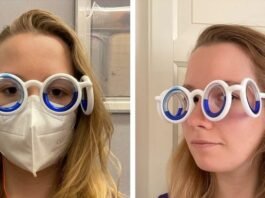High-index lenses—1. 74 index lenses to be exact—are the thinnest eyeglasses lenses. They are made to be a stylish and lightweight alternative for people with strong prescriptions. These lenses are substantially thinner than conventional lenses while retaining optical clarity because they are constructed of sophisticated high-index plastic. The Coke bottle effect, which is frequently connected to thick lenses, is lessened by the thinner profile which improves both the lens’s visual appeal and wearability. Aspheric technology is also incorporated into the thinnest glasses lenses to reduce peripheral distortion and improve visual quality.
How Do The Thinnest Eyeglasses Lenses Function?
It’s possible that you already know that light entering our eyes causes us to see things. When our system of lenses fails to function properly, we require vision correction (for nearsightedness, farsightedness or both). This causes blurred vision because it prevents our eyes from focusing an image on our retina, which functions as a movie screen when movies are projected onto it.
Prescribing lenses allow us to see clearly because they refract or bend light in a way that allows the focal point to be correctly adjusted depending on our power or prescription. When it comes to standard lenses the higher the prescription the more refraction your lenses require and the thicker they will be. Even for higher prescriptions, less material is needed because the thinnest eyeglasses lenses reflect more light.
What Determines the Thickness of the Lens?
The prescription, type of lens, and lens size all influence the total thickness of the lenses.
The prescription
In the end, it will dictate how thick your lenses are. To put it simply, a thicker lens corresponds to a higher prescription. Furthermore, prescriptions with moderate to high astigmatism correction frequently lead to the thinnest eyeglasses lenses.
Lens Index or Lens Material
The term index of refraction or the degree to which a lens bends light entering it is used to describe the lens index. When you wear your glasses, this guarantees that the light is properly focused onto the retina improving your vision. A thinner lens is generally associated with a higher index. A 1. 61 lens for instance is thinner than a 1. 50 lens.
Sizes of the lens
The overall breadth and height of your lenses can significantly influence the thickness and weight of the actual lenses. A lens’s thickness and weight increase with its size.
What Are The Thinnest Eyeglasses Lenses For Strong Prescription?
Lenses with a 1. 74 index are the thinnest options for high-prescription glasses. Compared to conventional lenses made of ordinary plastic, these lenses can be thinner and lighter because they are composed of high-index plastic. Compared to conventional lower index lenses 1. 74 index lenses have a thinner profile because of the flatter curve that is used in their construction.
However, peripheral distortion may result from the use of a flatter curve. Spherical aberration is removed through the incorporation of aspheric lens technology. Manufacturers can now offer far thinnest eyeglasses lenses for eyewear than they did in the past owing to the can now of high-index lenses. Adjusting could have a big impact on the thickness of your lenses if you’re used to a strong prescription in regular plastic. Although the thickness of a high prescription lens cannot be completely hidden by even the thinnest lens, it can significantly lessen its visibility.
Which Types Of Thinnest Eyeglasses Lenses Are Available?
Different gradients can be used to classify high-index lenses, which just adds another degree of complexity. As a result, they are assigned an index number.
1.5 index lenses
These lenses are mid-index standard lenses. Since they fit wearers with low prescription requirements between +1. 00 and -2. 75 they are likely the most popular index in thinnest eyeglasses lenses. Despite having a thicker lens, they are thought to be a more cost-effective option because the prescription isn’t too high. They will therefore be a little bit heavier and work best with full-rimmed glasses frames that can accommodate them.
1.6 index lenses
1. 6 which is 20% lighter and thinner than the standard index lens (1. 5) is regarded as a high-index lens. With stronger optical prescriptions between +3. 00 and -5. 75 they are intended to support wearers. But the thinner material reduces the bulky appearance that thicker lenses can sometimes give off and they are more comfortable. Consequently, they are compatible with the majority of eyeglass frame designs.
1.67 index lenses
1. 67 provides the same level of comfort and lightness to the wearer as 1. 6. Once more the lens is slenderized, which facilitates working with any kind of frame and produces a beautiful appearance. 1. 67 lenses improve vision for people with a +4. 75 to -6. 75 prescription requirement and are 33 per cent thinnest eyeglasses lenses than 1. 5 point lenses.
1.74 index lenses
Remarkably, 1. 74 index lenses have a 45 per cent thinnest eyeglasses lenses than regular lenses. This significantly lowers the weight of your glasses, giving you the utmost comfort without sacrificing the clarity of your vision. Notably thinner at this index, the lens fits well with all eyeglass frames and +5. 00–-7. 00 prescriptions.
1.9 index lenses
A specific kind of glass is used to make the highest-index lenses because glass has a higher refractive index than plastic. No matter which frame style you choose, 1. 9 lenses are the thinnest eyeglasses lenses and lightest lenses available for strong prescriptions. They are made to offer exact visual clarity and comfort.
Advantages Of The Thinnest Eyeglasses Lenses
Thinner Lenses
Double aspheric lenses which have a curvature on both the front and back of the lens surface are used to make the thinnest eyeglasses lenses. The lens’s features and efficacy remain unaffected, but the profile gets thinner as a result. This lessens both the lens weight and the bulky appearance of spectacles.
Less Heavy Lenses
It is possible to decrease the total weight of the glasses by decreasing the weight of the lens. People who must wear glasses all day will find a more comfortable fit thanks to this. Lightweight glasses reduce pressure points and headaches.
More Amazing Choices Are Accessible
Let’s say you discover a pair of glasses that you adore, but the frames are too small to accommodate the thick lens because you require a strong prescription. The thinnest glasses lenses are frequently light enough to fit into any kind of frame. To fit your style, they can also be applied to transitional polarized and tinted lenses.
Maximum Comfort
Wearers of glasses can enjoy a generally positive experience with high-index lenses. They eliminate pressure points and the tendency for them to slide down your nose because they don’t rest heavily on your ears or nose. Many wearers are also drawn to their slimmer appearance.
Furthermore, the thinner and integrated benefits account for the higher price point.
Scratch resistance. You may avoid the trouble of distracting marks in your field of vision by using high-index lenses which are more scratch-resistant than regular plastic.
Protection from UV rays. With their UV400 protection, thinnest glasses lenses can block up to 99 per cent of UVA and UVB radiation.
Lack of reflection. Besides improving visual clarity and easing eye strain, these high-index lenses will help to lessen glare and reflections.
Can I Get The Thinnest Eyeglasses Lenses?
The thinnest eyeglasses lenses may be a good option for a high prescription. Thin lens glasses have the advantages of being incredibly light scratch-resistant and UV protection. Remember that before choosing your next pair of prescription glasses, you should always speak with an eye doctor or one of our online opticians.



